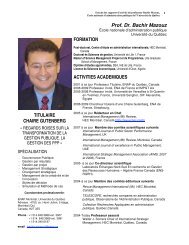Why do firms both make and buy? An investigation of concurrent ...
Why do firms both make and buy? An investigation of concurrent ...
Why do firms both make and buy? An investigation of concurrent ...
Create successful ePaper yourself
Turn your PDF publications into a flip-book with our unique Google optimized e-Paper software.
310 A. Parmigiani<br />
Sutcliffe K, Zaheer A. 1998. Uncertainty in the transaction<br />
environment: an empirical test. Strategic Management<br />
Journal 19(1): 1–23.<br />
Teece DJ. 1982. Towards an economic theory <strong>of</strong> the<br />
multiproduct firm. Journal <strong>of</strong> Economic Behavior <strong>and</strong><br />
Organization 39: 39–63.<br />
Teece DJ, Pisano G, Shuen A. 1997. Dynamic capabilities<br />
<strong>and</strong> strategic management. Strategic Management<br />
Journal 18(7): 509–533.<br />
Tomaskovic-Devey D, Leiter J, Thompson S. 1994.<br />
Organizational survey nonresponse. Administrative<br />
Science Quarterly 39: 439–457.<br />
Trigeorgis L. 1995. Real Options in Capital Investment.<br />
Praeger: Westport, CT.<br />
Tunisi A, Zanfei A. 1998. Exploiting <strong>and</strong> creating<br />
knowledge through customer–supplier relationships:<br />
lessons from a case study. R&D Management 28:<br />
111–118.<br />
Von Hippel E. 1988. The Sources <strong>of</strong> Innovation. Oxford<br />
University Press: New York.<br />
Walker G, Poppo L. 1991. Pr<strong>of</strong>it centers, single source<br />
suppliers, <strong>and</strong> transaction costs. Administrative<br />
Science Quarterly 36: 66–87.<br />
Walker G, Weber D. 1984. A transaction cost approach<br />
to <strong>make</strong>-or-<strong>buy</strong> decisions. Administrative Science<br />
Quarterly 29: 373–391.<br />
Wernerfelt B. 1984. A resource based view <strong>of</strong> the firm.<br />
Strategic Management Journal 5(2): 171–180.<br />
Williamson OE. 1975. Markets <strong>and</strong> Hierarchies: <strong>An</strong>alysis<br />
<strong>and</strong> <strong>An</strong>titrust Implications. Free Press: New York.<br />
Williamson OE. 1985. The Economic Institutions <strong>of</strong><br />
Capitalism: Firms, Markets, Relational Contracting.<br />
Free Press: New York.<br />
APPENDIX: SURVEY ITEMS<br />
Dependent variable<br />
1. For the past fiscal year, which best describes<br />
how you source progressive stamping dies?<br />
� All <strong>do</strong>ne internally (either within your plant or<br />
from a division with which your firm shares a<br />
common corporate parent)<br />
� All purchased from external suppliers<br />
� Both <strong>do</strong>ne internally <strong>and</strong> purchased from external<br />
suppliers<br />
(i) If you marked this response, what % <strong>of</strong><br />
your requirements did you produce internally<br />
(please mark one)?<br />
� 0–10% � 26–49% � 75–90%<br />
� 11–25% � 50–74% � Over 90%<br />
� Don’t use this input<br />
Independent variables<br />
Each item included a response scale <strong>of</strong> 1 to 7,<br />
indicating totally true to totally untrue. Items were<br />
edited to reflect each different good (e.g., ‘dies’<br />
was replaced with ‘surface coating’). This resulted<br />
in five similar four-page sections, one section for<br />
each good. (Items adapted from prior work are<br />
designated by citations; other items are original.)<br />
Asset specificity<br />
1. The skills needed to create dies are generic <strong>and</strong><br />
widely available (reversed).<br />
2. Numerous capable die suppliers exist in the<br />
market (Walker <strong>and</strong> Weber, 1984; reversed).<br />
3. Switching die suppliers would be quick <strong>and</strong><br />
easy to <strong>do</strong> (Poppo <strong>and</strong> Zenger, 1998; reversed).<br />
Volume uncertainty<br />
1. Our forecasts for dies are very accurate (<strong>An</strong>derson<br />
<strong>and</strong> Weitz, 1986; reversed).<br />
2. There are predictable patterns to our requirements<br />
(<strong>An</strong>derson <strong>and</strong> Weitz, 1986; reversed).<br />
Technological uncertainty<br />
1. The processes <strong>and</strong> skills required to create dies<br />
are mature <strong>and</strong> unlikely to change in the future<br />
(Heide <strong>and</strong> Weiss, 1995; reversed).<br />
2. Major die innovations are very likely within the<br />
next few years (Bensaou <strong>and</strong> <strong>An</strong>derson, 1999).<br />
3. Major innovations in how dies are produced are<br />
very likely within the next few years (Bensaou<br />
<strong>and</strong> <strong>An</strong>derson, 1999).<br />
Performance uncertainty<br />
1. We can easily describe dies to our suppliers<br />
through printed/electronic descriptions <strong>and</strong>/or<br />
drawings (reversed).<br />
2. Through a simple inspection, we can predict<br />
how well the die will function in our <strong>do</strong>wnstream<br />
production processes (Bottum, 1992;<br />
reversed)<br />
3. We use several forms <strong>of</strong> inspection <strong>and</strong> several<br />
different metrics to evaluate die quality (<strong>An</strong>derson<br />
et al., 2000).<br />
4. When there is a problem with a die, we usually<br />
can determine its cause (reversed).<br />
Copyright © 2007 John Wiley & Sons, Ltd. Strat. Mgmt. J., 28: 285–311 (2007)<br />
DOI: 10.1002/smj





